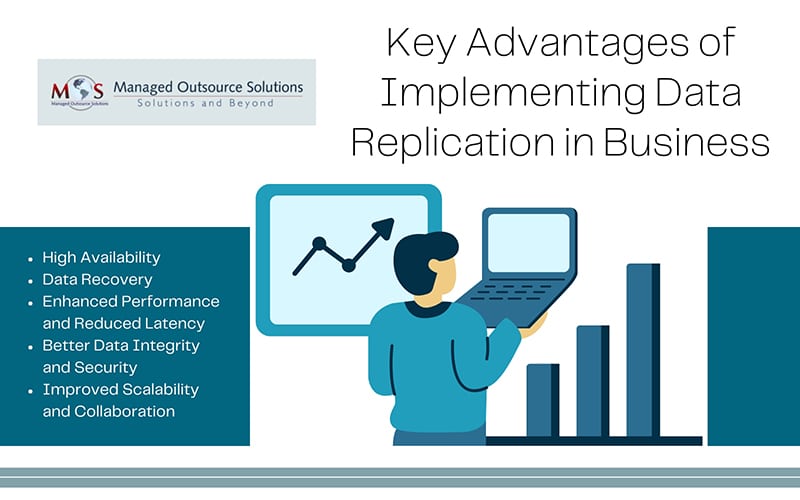The significance of access to real-time information cannot be overstated in today’s business landscape, as it directly influences key factors such as customer experience, market opportunities, and timely deliveries. In an increasingly connected world, businesses that neglect real-time data sharing risk falling behind and jeopardizing their success. However, several factors, such as system failures or natural disasters, can disrupt access to this critical information.
To ensure uninterrupted access and maintain operational continuity, companies must implement a robust data replication system. Outsourced solutions implement a reliable replication process, providing businesses with expert support to manage and scale their database infrastructure effectively. For organizations, this technical strategy offers substantial strategic advantages, particularly in performance, scalability, and security.
What Is Data Replication?
Data replication refers to the process of creating and storing multiple copies of the same data across different locations, systems, and databases. By leveraging this technique, organizations can ensure availability, accessibility, and reliability of their business intelligence assets. Doing so allows companies to continue operations even in the event of database unavailability due to system failures, disasters, or breaches.
Data replication is utilized as part of data capture and recovery strategies in organizations and can occur in real time, near real time or in batches. There are mainly two methods that businesses can employ to perform this process – synchronously and asynchronously. In synchronous replication, the dataset is replicated to both primary and secondary servers simultaneously. Whereas in asynchronous replication, the dataset is first replicated to the primary server and then copied to secondary servers at scheduled intervals.
Key Benefits of Data Replication in Business
Data replication is a crucial component of a robust data management strategy for any organization. Below are the key benefits of implementing this process:
- High availability
By storing datasets across multiple servers, organizations can ensure continuous access to information, even during disruptions. This is especially critical for businesses with a global reach, enabling teams to maintain daily operations, minimize downtime, and respond to events in real time. Since replication is an ongoing process, it ensures that the mirrored dataset is consistently updated and synchronized with the original source.
- Data recovery
Business continuity is a cornerstone of any successful operation. In an era where cyber-attacks, hardware failures, and natural disasters are all too common, being prepared for the unexpected is no longer optional—it’s a necessity. One of the most critical benefits of this process is its role in disaster recovery (DR) strategies. By maintaining a distributed database environment, companies can quickly failover to a secondary copy even during a catastrophe, ensuring seamless business operations.
- Enhanced Performance and Reduced Latency
In the modern business landscape, speed is a competitive advantage. Whether processing real-time analytics, generating reports, or delivering customer orders, quick database access is the key to success. Replication enhances performance by providing copies of dataset closer to the user’s location or where transactions occur. This reduces latency, improves fault tolerance, accelerates processing, and boosts server performance. Additionally, distributing the load across multiple servers prevents any single server from becoming overloaded, further enhancing the overall responsiveness of applications.
- Better Data Integrity and Security
Data integrity is essential for accurate analysis, retaining customer trust, and ensuring regulatory compliance. A single point of failure, such as a corrupted dataset or accidental deletion, can have severe consequences. Replication offers redundancy, ensuring that even if the original dataset becomes corrupted, businesses can restore and access accurate replicas from unaffected backups. In industries like healthcare, finance, and legal services—where data security is paramount—it provides an extra layer of protection. By maintaining multiple copies of a database, companies can safeguard against human errors, software bugs, and malicious attacks, preserving the integrity of their information and reducing the risk of costly mistakes, compliance issues, and security breaches.
- Improved Scalability and Collaboration
As businesses grow, scaling database infrastructure that accommodates increasing volumes of information becomes a critical challenge. Replication supports this need by enabling scalable storage and access across distributed systems. Instead of relying on a single server or database that may become overwhelmed, this process allows companies to build a distributed environment that can efficiently handle rising demand. With replicas spread across multiple locations or cloud environments, teams around the world can access and update databases in real time. This fosters seamless collaboration, improves decision-making, and accelerates business processes. Whether sharing customer insights, analyzing sales performance, or processing additional transactions, businesses can scale without sacrificing performance or uptime.
How to Implement Data Replication in Your Business
In today’s fast-paced business environment, data is at the core of decision-making, customer experiences, and operational efficiency. By duplicating datasets across various locations or systems, you can protect your business from potential disruptions such as server failures, database corruption, or hardware issues. Moreover, it enhances performance by enabling quick access to information across different regions, ensuring business operations run smoothly.
While implementing a replication process in your business may seem complex, it can be executed smoothly with a clear plan. Here’s how you can effectively execute it in your business:
- Assess Your Data Needs
Before diving into the replication process, it’s crucial to understand the types of data your business manages and their unique requirements. Various dataset types come with different needs, including: –
- Transactional – demands high consistency and minimal latency
- Big data – necessitates periodic replication for analysis
- Backup – requires regular copies for disaster recovery
Assessing your business’s dataset types will help you determine how often to replicate, where to replicate, and which technology to use.
- Choose the Right Replication Method
When it comes to replication techniques, there are various methods available, and choosing the right one depends on your specific needs and infrastructure. The two main types are:
- Synchronous: This method copies dataset in real time, ensuring both primary and secondary locations are always up-to-date. It’s ideal for businesses that cannot afford any downtime, but may impact system performance.
- Asynchronous: In this approach, the dataset is replicated at set intervals, which makes it more efficient for handling larger datasets, though there is a slight delay in the replication process.
Each method has its own advantages and disadvantages, so it’s crucial to assess your business requirements thoroughly.
- Implement the Right Technology and Tools
Businesses have numerous applications they can choose from including cloud-based solutions and on-premises software. Some well-known options are:
- Cloud services like AWS DataSync or Microsoft Azure’s Site Recovery
- Database-specific tools such as Oracle GoldenGate or MySQL replication
When choosing a tool, consider your IT infrastructure, scalability requirements, and budget. Cloud solutions often provide easy scalability and disaster recovery features, while on-premises options may offer greater control over your data.
- Ensure Security and Compliance
Replicating datasets across multiple systems can heighten the risk of security breaches and data corruption. Therefore, it’s crucial to establish strong security measures, which include:
- Encryption: Ensure that datasets are encrypted both in transit and at rest to protect sensitive information.
- Access control: Implement strict permissions to determine who can access, modify, or delete replicates.
- Compliance: Verify that your data management practices comply with industry regulations such as GDPR or HIPAA, especially when dealing with customer or health information.
A comprehensive security framework will help protect against unauthorized access and reduce potential risks.
- Monitor and Test Regularly
After setting up your replication system, it’s crucial to monitor and test it regularly to ensure that the process is running smoothly. Regular checks should include:
- Latency and performance monitoring to ensure replication doesn’t negatively impact system performance.
- Data consistency checks to verify that replicates match the source.
- Failover and disaster recovery tests to ensure the system functions correctly during a failure.
Establishing a strong monitoring system will help identify potential problems early on, keeping your process efficient and dependable.
Integrate Replication Strategy with Outsourcing
By partnering with an outsourcing company, businesses can leverage specialized expertise and resources to optimize their data replication strategy. Implementing a replication process is essential for building a resilient, efficient, and secure data infrastructure. Outsourcing companies can provide scalable solutions, advanced tools, and continuous monitoring, helping organizations stay ahead of the curve. It ensures businesses always have access to reliable, up-to-date information—whether for daily operations, disaster recovery, or maintaining business continuity. With careful planning and the right outsourcing partner, companies can establish a robust data replication strategy that supports their long-term success and competitiveness.





